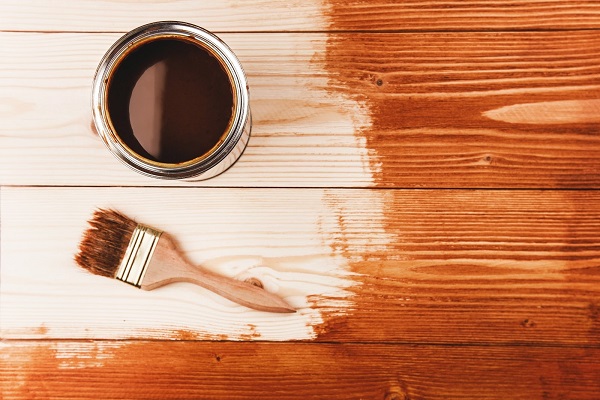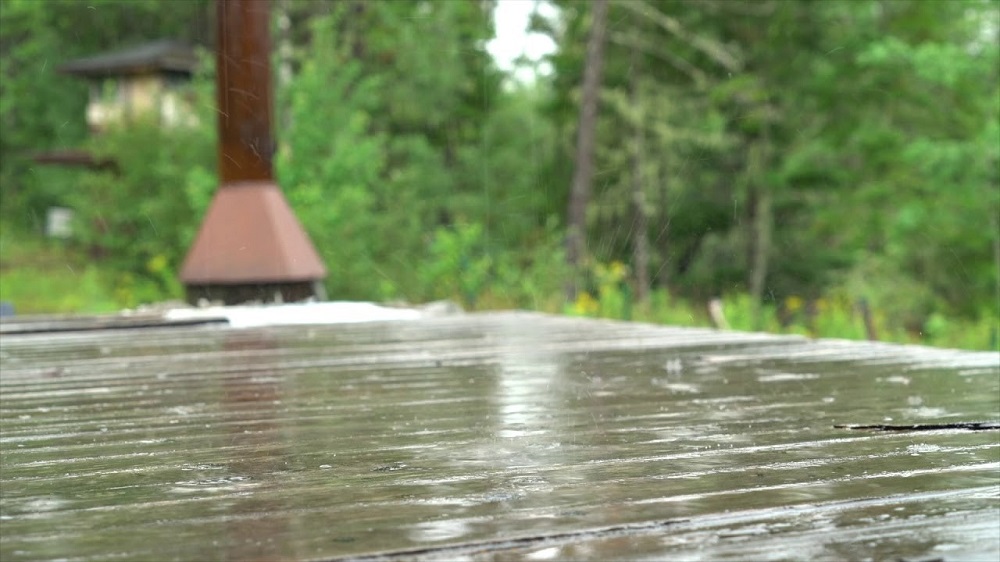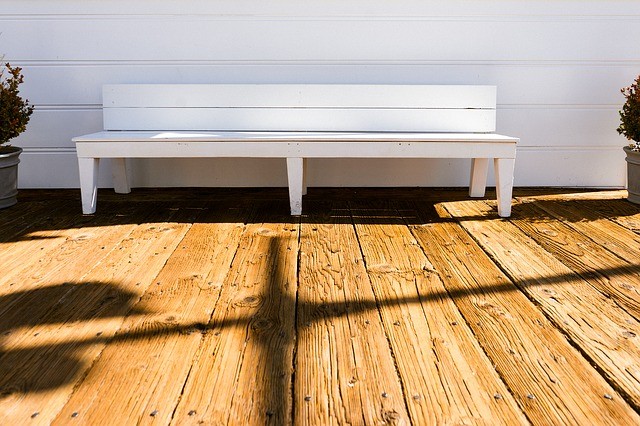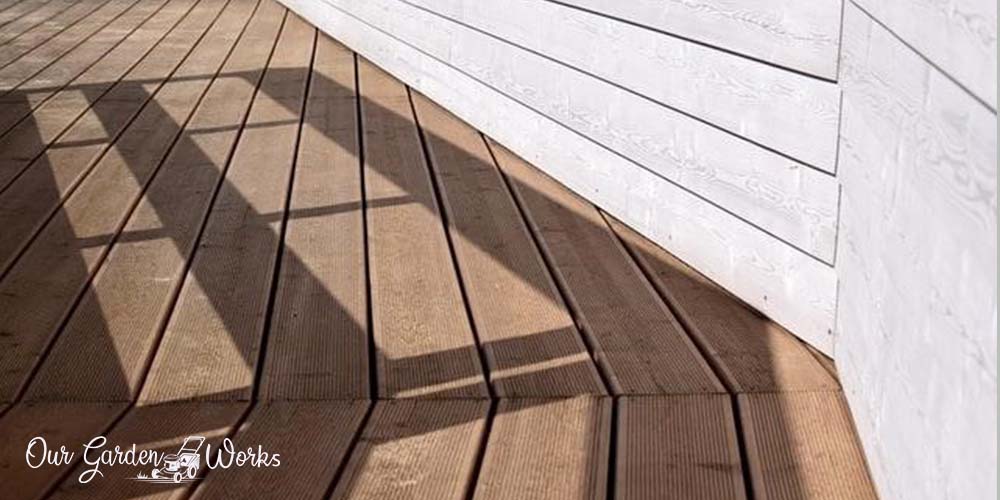When the weather is not on your side, projects such as staining your deck can turn into a nightmare.
As easy as it may seem, staining a deck takes careful planning and certain techniques to properly execute. Otherwise, you’ll end up with a rotten deck in no time.
Learn how long does the stain need to dry before the rain comes and how to stain it with the right coating strokes, timing, and materials. Save yourself some effort and do it right the first time by following the steps we’ll discuss in this post.
Q: How long does the Deck Stain need to dry before it rains?
Water-based or latex stains take 4 to 6 hours to dry thoroughly and prevent spots due to rain. On the other hand, oil-based stains should be dried for 12 to 24 hours before the rain comes. Oil stains need more time to seep into the wood and be absorbed by the fibers.
Other than the drying time, you have to learn how wood stains work and the proper ways of using them on your deck.
Understanding Wood Stains
A wood stain helps protect the wood from the harsh sun and moisture. It also helps prevent the wood from cracking when it dries out.
Unlike wood stain, sealers like varnish, are only intended to protect the wood from wearing down due to sun damage but not from moisture.
Staining is more like curing the wood than painting it. Think of it as a way of preparing your deck for the extreme weather conditions that it will endure for the whole year. Curing allows the stain to settle into the outer layer of the wood and bring out its best natural color.
Aside from protecting the wood from the weather and decay, it also helps decrease the chances of fungal growth.
Types of Wood Stains

There are two types of stains that you can use for your deck. Using each type of stain depends on the state of the wood and your preference. The two types include:
Water-based or Latex Stains
Water-based stains dry quickly than it’s oil counterpart that makes it best for large decks. It can last for 4 to 6 years and resistant to mildew and mold. The water-based stain is also safer to use because it is not flammable and doesn’t contain toxic fumes.
Below are the timbers with natural resistance to rotting that work best with a water-based stain:
- Cypress
- Cedar
- Redwood
Oil-based Stains
An oil-based stain may take a longer time to dry up but it penetrates deeper into the wood. It is the best choice if your deck receives direct sunlight, rain, and wind. You may also bring out the best color of the deck when you use oil-based stains it is newly built.
Factors That Affect The Stain Finish on Wood
Both types of wood stains have their own set of benefits. If you’re having a hard time deciding which one to choose, here are some of the factors that you have to consider before you buy one:
- Location: Decks stained with oil stains that are exposed to direct sunlight lasts longer compared to decks stained with a water-based stain. The heat of the sun allows the oils to be absorbed by the wood completely.
- Exposure to weather conditions: If you use water stain for decks that will withstand extreme weather conditions, you will need to stain it again every spring.
- Age of wood and type of timber: Every timber reacts differently to stain. So, make sure to do a patch test first before applying anything on the deck. Allot 1 to 2 months before you stain decks made up of pressure-treated and green-treated wood.
On the other hand, stain newly built decks immediately if they are built with:
- Stain cedar
- Redwood
- Exotic hardwoods
- Clear pressure-treated
Recommended For You: Tips on How To Remove Crayon From Wood
Ideal Conditions For An Evenly Stained Deck

The wood on your deck needs to be in perfect condition before you stain it. Here are the ideal conditions that will help you stain your deck like a pro:
- The deck should be clean and dry before staining. If you washed the deck, dry it for at least 24 to 48 hours to remove the moisture out of the wood. Curing stains on wet or moist wood will trap the water inside causing the wood to rot from the inside.
- The best temperature for staining is 80 degrees Fahrenheit or 26 degrees Celsius because the stain is best absorbed by the wood if it is dry and cool.
- The best time to stain is if the weather forecasts report 1 to 2 consecutive days of no chance of rain.
- The moisture level of the wood should not exceed 12% to 15%. Otherwise, the deck needs more drying.
Things To Avoid When Staining a Deck
To get the best results, here are the things that you should avoid when choosing a stain and applying it:
- Do not use light stain for decks thaw was stained with a darker shade.
- Do not stain the deck under direct sunlight. The stain will dry quicker and you will miss the right timing to do the second coating.
- Too much coating will cause flaking and peeling on the surface of the wood.
- Do not attempt to stain your deck if the forecast tells you that it will rain in the afternoon. You may start as early as you can but the stain will not have enough time to dry thoroughly.
How To Fix The Deck When Rain Poured Over The Wet Stain?

Sometimes, the weather can be too unpredictable. When your deck has just been stained and the rain pours over it.
Here are some of the steps that you can try to fix the problem:
- If the rain is just a drizzle the water may not be enough to penetrate into the wood and affect the stain.
- To check if the rain damaged the stain, wait until the rain stops and the deck dries up. If the rain is a heavy downpour, check for pockets, blotches, or white spots since these are the signs that the stain is damaged by the rainwater.
- Check the labels on the stain can and see if the stain can withstand water and moisture even if not fully dried up.
- If you find some blotches, you can recoat a small area and see if it will be restored. Another option is to use a wood cleaner through a pressure washer to wash the blotches away. Otherwise, you’ll need to strip the stain or sand the wood again and repeat the whole process.
Reminder: Decks stained with an oil-based stain that’s not yet dry will receive more damage from the rain since the oil takes time to settle on the wood. On the other hand, staining the wet wood will end up with a splotched, peeling, or flaking wood surface.
Tips In Staining Decks

You don’t have to be a professional to stain a deck. You only need to be careful and have an attention-to-detail, especially when it comes to rain forecasts and the right timing in between coatings.
Here are some tips that might also help you do the job easier:
- For an even application of stain, start with the railings before you work on the floor to avoid stain drips.
- Close a 50 square feet area starting from your work area to make sure that if you spill the stain, you can mop it evenly within 15 to 20 minutes.
- Follow the direction of the grain when you mop or brush the stain.
- Some people find using the handled carwash push brush a good tool to evenly stain their deck.
- Stain your deck every year if it’s exposed to direct sunlight.
- Make sure that the tannins in the timber are removed before staining them
- To know if the deck is ready for the second coating, gently touch the wood and see if it’s no longer wet and a bit sticky.
- Avoid accidents by soaking the used rag for oil-based stains in water.
- Newly built decks are not required to be cleaned. A wood cleaner would do the trick to make the stain stick to the wood and prevent it from peeling.
Recommended For You: 10 Ways To Cover Up Mud In Your Backyard
Frequently Asked Questions
What happens if it rains on freshly stained decks?
If the deck was dried for 4 to 6 hours using the water-based stain, it may not get too much damage from the rain. Oil-stained decks are a different story since oil needs more time to penetrate the wood. The damage will show as blotchy patterns and white spots will appear.
Should I apply the second coat on the second half even though it will be the afternoon before the rainy day?
If you are using a water-based stain, you can apply the second since there’ll be enough 4 to 6 hours to allow it to dry. Oil=stained decks should not be coated because you’ll only end up with damaged stains and repeating the whole process.
Should I not do anything and leave the recently sanded deck to get wet and then wait for the rainy days to stop?
Yes, it can be hard to wait but the wood should be perfectly dry before you stain it. It should also have enough time to dry the stain to prevent any damages to the finish. Otherwise, you’ll end up with two consequences: rotten deck and blotchy stained deck.
How many coats of stain does a deck need?
You only need two coats of stain. Too much coating will only end up with flaking and peeling.
Can you use a roller to stain a deck?
You can use a roller and brush to stain your deck. It’s also best if you can use a pan to make staining easier and more convenient. Water-based stains can also be applied with a sprayer to make it easier to stain bigger decks.
Will multiple coats of stain make it darker?
Yes. Make sure the first coating dully dried before you start applying the second coating of the stain. However, it will only be a shade darker so if you’re expecting a darker tint, you should choose a darker shade of stain and don’t make the mistake of too much coating.
What happens if you don’t wipe off stain?
Wood can only absorb so much of stains and any excess stain will remain on the surface of the wood. If left unwiped, the excess stain will become sticky.
How long should you let the stain dry between coats?
While every type of stain has a different reaction on wood, the average time in between coats is one hour. However, it is suggested that when you touch the first coat and it’s no longer wet but rather tacky, you can apply the second coating.
Should you sand after staining?
Never sand after staining the wood because it will remove the stain itself. Instead, you can sand the wood before staining it to make the surface smooth and improve the finish of the wood.
Final Thoughts
Staining your deck is like cooking. It requires the right timing, the right amount of stain and the patience to allow the wood to be in its perfect condition for staining and get the best results.
We hope that this article made it easier for you to take note of the important things that you should remember while doing your staining project. If you enjoyed staining your deck using this guide, share this post with your friends before the rain starts ruining their decks.
Let us know how your decks turned out after you stained them in the comments below. Who knows you discovered a new hack!
See you at our next DIY project!

I rub mustard on my entire deck before staining. It worked out perfectly…for the rodents (bada bada bing).